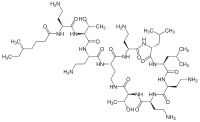
Photo from wikipedia
Colistin is a last-resort antibiotic in fighting severe infections caused by multidrug resistant Gram negative pathogens in hospitals. Zoonotic bacteria acquire colistin resistance in animal reservoirs and mediate its spread… Click to show full abstract
Colistin is a last-resort antibiotic in fighting severe infections caused by multidrug resistant Gram negative pathogens in hospitals. Zoonotic bacteria acquire colistin resistance in animal reservoirs and mediate its spread along the food chain. This is the case of non-typhoid serovars of Salmonella enterica. Colistin-resistant S. enterica in foods represents a threat to human health. Here, we assessed the prevalence of colistin-resistance in food-borne isolates of S. enterica (2014–2019; Asturias, Spain), and established the genetic basis and transferability of this resistance. Five out of 231 isolates tested (2.2%) were resistant to colistin. Four of them, belonging to the European monophasic ST34 clone of S. Typhimurium, were characterized in the present study. They were collected from pork or pork and beef meat-derived products, either in 2015 (three isolates) or 2019 (one isolate). Molecular typing with XbaI-PFGE and plasmid profiling revealed distinct patterns for each isolate, even though two of the 2015 isolates derived from the same sample. The MICs of colistin ranged from 8 to 16 mg/L. All isolates carried the mcr-1.1 gene located on conjugative plasmids of the incompatibility groups IncX4 (2015 isolates) or IncHI2 (2019 isolate). Apart from colistin resistance, the four isolates carried chromosomal genes conferring resistance to ampicillin, streptomycin, sulfonamides and tetracycline [blaTEM–1, strA-strB, sul2, and tet(B)] and heavy metals, including copper and silver (silESRCFBAGP and pcoGE1ABCDRSE2), arsenic (arsRSD2A2BCA1D1) ± mercury (merEDACPTR), which are characteristically associated with the European ST34 monophasic clone. The 2019 isolate was also resistant to other antibiotics, comprising third generation cephalosporins and cephamycins. The latter phenotype was conferred by the blaCMY–2 gene located on an IncI1-I(α)-ST2 plasmid. Results in the present study identified meat-derived products as a reservoir of a highly successful clone harboring transferable plasmids which confer resistance to colistin and other clinically important antibiotics. An important reduction in the number of food-borne S. enterica detected during the period of the study, together with the low frequency of colistin resistance, underlines the success of One Health initiatives, such as those implemented at the UE, to control zoonotic bacteria along the food chain and to halt the spread of antimicrobial resistance.
Journal Title: Frontiers in Microbiology
Year Published: 2021
Link to full text (if available)
Share on Social Media: Sign Up to like & get
recommendations!